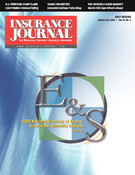The events of the past six months — and those of the past several years — are some of the most dramatic in the history of financial services and risk management. From Sept. 11, to the 2005 hurricanes, to the current economic downturn, in less than one decade we have experienced a series of events that have altered our industry and the world for years to come.
Everyone wants to know what the current financial crisis will mean. Everyone has an opinion, but no one — myself included — knows all the answers. Each catastrophe, be it a hurricane or a financial meltdown, has its own set of unique variables. We currently face an asset-driven crisis, one that makes it difficult to predict the end game with any certainty. But I do have one observation, a trend that I expect to see in 2009.
It’s what I call the invisible hard market.
The industry is already beginning to see the signs of a hardening market — although the financial storm may have obscured it. But it’s a unique hard market, one that will evolve differently than any hard market we’ve experienced in the last 50 years. Some doomsayers claim this represents the failure of Western-style capitalism. This extremism is nonsense. But it is true that our road to recovery remains long and potentially bumpy. Governments around the world have stepped in. Our collective insecurities will continue to constrain borrowing in 2009. Companies will maintain deeply cautious outlooks, and sit on their cash. Investors will likely be just as cautious.
What a difference a year makes. At the start of 2008, we started the year in a soft market. Insurance was readily available and premium rates, in most cases, were falling. We had an abundant surplus in the market — a surplus surplus.
In our industry, when market conditions change they tend to do so fairly visibly. Something occurs that increases prices, premiums tend to rise very quickly — at a rate more rapid than underlying exposures. When we stand at the doorway of a hardening market, everyone knows it. And all of the repercussions of a strengthening market kick in.
But here we are, a year later, with a market turned on its head. The chaotic and uncertain environment has dramatically reduced supply but increased demand for protection. Higher prices and declining exposures equal a harder market – right? Right. But other factors are at work here, and when you combine them, the true effect is more subtle than at any other time I can remember.
This time, a hardening market comes into play against the backdrop of staggering losses in the financial markets. Insurers reported deep investment losses for the third quarter of last year and are set to do the same for the fourth quarter.
We’re in uncharted waters now. For at least some period of time, we will be in an environment where premium rates rise but underlying exposures decline. There is, therefore, a better relationship between pricing and exposure, but it may not produce meaningful change in the top line. Without a meaningful change in the top line, there may not be a dramatic change in the absolute level of underwriting income. The countervailing forces of rising rates and declining exposures producing the same top line may not translate immediately into an improved bottom line.
Couple that with continuing declines in investment income, and the insurance industry will likely report flat or only modest gains in total income — even though the market has indeed hardened and the quality of their earnings has improved. Hence, an invisible hard market.
This won’t persist forever. The invisible hard market will become visible at some point, although when remains unclear. Potential catalysts: A rebounding economy, increased exposures, normalized investment income or a major insurable event. If there is a major event, it could dramatically affect rate change.
If the market conditions that I have described come to pass, leaders in our industry will be tested. In many ways, despite the signs we see of a hardening market, we will have to manage with a “soft market” mentality. The instant gratification that usually accompanies a hard market won’t be there at first. You’ll be asking ask more of your teams and getting better value in underwriting — but you won’t see that reflected immediately. You’ll have to do what we always do in soft markets — maintain a hand on expenses, and employ rigorous underwriting discipline and claims management processes.
My advice is to stay optimistic, engaged, and proactive. We will pull through it — we always do.
Was this article valuable?
Here are more articles you may enjoy.


 Berkshire Hathaway Raises New CEO Abel’s Salary to $25 Million
Berkshire Hathaway Raises New CEO Abel’s Salary to $25 Million  Is the AI Boom a Bubble Waiting to Pop? Here’s What History Says
Is the AI Boom a Bubble Waiting to Pop? Here’s What History Says  Litigation Funding, Other New Laws in SE States Could Impact Liability Insurance
Litigation Funding, Other New Laws in SE States Could Impact Liability Insurance  Cloudy Future for Bourbon Has Jim Beam Closing Distillery for a Year
Cloudy Future for Bourbon Has Jim Beam Closing Distillery for a Year 


